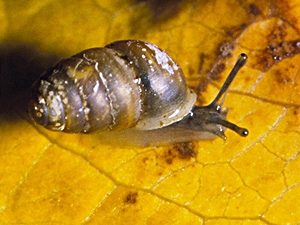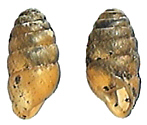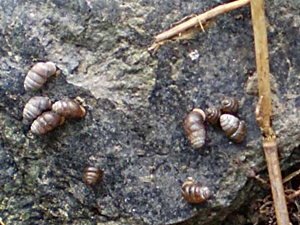
Common chrysalis snail (Lauria cylindracea).
Picture: Kristiina Ovaska. Source: CalPhotos.
The vernacular name chrysalis snails describes several families of snails, especially the Pupillidae. Actually, the Lauriidae do not exactly have a common or vernacular name on their own.
Common Chrysalis Snail - Lauria cylindracea (Da Costa 1778)
 Common chrysalis snail (Lauria cylindracea). Picture: Kristiina Ovaska. Source: CalPhotos. |
Description: The common chrysalis snail has a brown translucent and shiny shell, whose oval form ends in a blunt shell tip (apex). The last of the slightly rounded whorls has the largest diameter. The shell aperture in adult specimens is folded back to form a white lip. Usually a whitish parietal callus can be seen. The shell navel (umbilicus) is open, but narrow.
A common chrysalis snail's aperture shows two lamellae: A parietal (upper) lamella, visible as a tooth in the aperture, and a columellar (lower) lamella, which is only visible at an oblique view into the aperture.
![]() See also: Schileyko,
A. A. (1998): "Treatise on Recent Terrestrial Pulmonate Molluscs".
Part 1. Ruthenica, Appendix 2.
See also: Schileyko,
A. A. (1998): "Treatise on Recent Terrestrial Pulmonate Molluscs".
Part 1. Ruthenica, Appendix 2.
The chrysalis snail's body is dark coloured, foot and flank usually are a bit lighter coloured. The upper tentacles are quite short, the lower ones very short. When the snail is moving, it carries its shell at a very upright, almost vertical, position.
Dimensions: H: 3 - 4 mm; W: 1,8 mm; N: 5 - 6. (Abbreviations).
 Lauria cylindracea (3,7 mm). Bild: Helmut Nisters. |
Habitat and Distribution: The common chrysalis snail inhabits forests, rocks and meadows in places not too humid. Often it hides in large numbers under ivy leaves. While chrysalis snails on the southern Crimea peninsula are found ten times more frequently in dry places under stones and dead wood, than in humid places, in Portugal the species prefers humid and shady habitats and appears on mosses, under stones and dead wood, as well as on tree bark. In Britain finally it is most frequently found hidden at the top of walls, under ivy leaves. Lauria cylindracea is an ovoviviparous snail species which never lays eggs but gives birth to juveniles with 2 to 2½ whorls.
 Lauria cylindracea on a stone in British Columbia, Kanada. Picture: G. Holm (Source). |
Lauria cylindracea is found in those regions of West Europe influenced by the Atlantic (British Isles, France, Belgium, Netherlands, North Germany, Denmark), in the coastal areas of Scandinavia (as far north as 64° N. L.; isolated on the Lofotes islands), the Orkney islands, South Europe as far east as the Crimea peninsula, the Near East (Lebanon, Upper Galilee in Israel) and in Yemen in the Arabic south-west. There have also been some isolated findings in western Switzerland, the central Rhine valley, Mecklenburg-West Pomerania and at the Isteiner Klotz (Baden-Württemberg).
In the meantime, the species has also been introduced to New Zealand, South Africa and the Canadian south-west coast (as well as the US north-west coast respectively).
Threat Situation: As it is very common in South Europe (the commonest terrestrial snail species after the brown garden snail (Cornu aspersum) in Portugal), and also very frequent on old walls in Albanian cities, so the common chrysalis snail is also quite frequent on the British Isles. It is, though, in decline in the Midlands. In Switzerland, the species only appears in very warm and dry places, many habitats have already been destroyed, which has resulted in the species' disappearance except few populations.
In Rhineland-Palatinate, Lauria cylindracea is critically endangered
(CR), in Germany generally endangered (EN), in Switzerland and Albania it is
classified as vulnerable (VU) (see also:
![]() IUCN Threat Categories).
IUCN Threat Categories).
In Austria, there is only one species of the Lauriidae family, the southern chrysalis snail (Lauria sempronii), which probably is already extinct (See Checklist of Austrian Mollusca, Wikipedia: Südliche Puppenschnecke).
Systematics: The systematic position of the Lauriidae is different, depending on which author is consulted: Kerney and Cameron (1979) place the group within the Pupillidae, Schileyko (s. o.) positions them within the Orculidae family. According to Mollbase, the family is to be arranged next to Pupillidae, as well as Orculidae, in a family on its own. So the Lauriidae family shares the superfamily Pupilloidea with the whorl snails (Vertiginidae) and the grass snails (Valloniidae):
Class:
Gastropoda
![]() Subclass:
Pulmonata
Subclass:
Pulmonata
![]() Superorder:
Eupulmonata
Superorder:
Eupulmonata
![]() Order:
Stylommatophora
Order:
Stylommatophora
![]() Suborder:
Orthurethra
Suborder:
Orthurethra
![]() Superfamily:
Pupilloidea
Superfamily:
Pupilloidea
![]() Family:
Lauriidae Thiele 1931 1925
Family:
Lauriidae Thiele 1931 1925
![]() Source:
Mollbase on
http://www.mollbase.de/list/.
Source:
Mollbase on
http://www.mollbase.de/list/.
Links
![]() Mollbase:
Genabelte Puppenschnecke (Lauria cylindracea).
Mollbase:
Genabelte Puppenschnecke (Lauria cylindracea).
![]() Francisco Welter-Schultes:
Lauria cylindracea species homepage.
Francisco Welter-Schultes:
Lauria cylindracea species homepage.
![]() Aydin Örstan:
Land Snails of Turkey: Lauria cylindracea.
Aydin Örstan:
Land Snails of Turkey: Lauria cylindracea.
Literature
![]() Anderson, R. (2008): "An annotated list of the non-marine Mollusca of Britain and
Ireland" (PDF).
Anderson, R. (2008): "An annotated list of the non-marine Mollusca of Britain and
Ireland" (PDF).
![]() Rösch,
V.; Weiss, F. (2009): "Ein
Nachweis der Genabelten Puppenschnecke Lauria cylindracea (Da
Costa 1778)
am Isteiner Klotz: erster Lebendnachweis in Baden-Württemberg (Gastropoda:
Stylommatophora: Lauriidae)". Mitt. dtsch. malakozool. Ges. 81: 29 - 30 (PDF).
Rösch,
V.; Weiss, F. (2009): "Ein
Nachweis der Genabelten Puppenschnecke Lauria cylindracea (Da
Costa 1778)
am Isteiner Klotz: erster Lebendnachweis in Baden-Württemberg (Gastropoda:
Stylommatophora: Lauriidae)". Mitt. dtsch. malakozool. Ges. 81: 29 - 30 (PDF).
![]() Wimmer,
W.; Teichler,
K.-H. (2005): "Lauria cylindracea (Da
Costa 1778)
(Gastropoda: Lauriidae) im Botanischen Garten Braunschweig – Erstnachweis für
Niedersachsen". Braunschweiger Nat. Schr. 7 (2): 339 - 343 (PDF).
Wimmer,
W.; Teichler,
K.-H. (2005): "Lauria cylindracea (Da
Costa 1778)
(Gastropoda: Lauriidae) im Botanischen Garten Braunschweig – Erstnachweis für
Niedersachsen". Braunschweiger Nat. Schr. 7 (2): 339 - 343 (PDF).